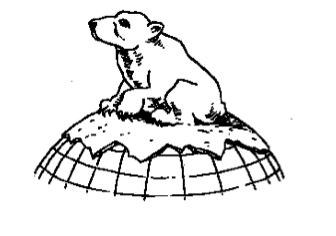The North Pole
It was morning when we reached the North Pole, though the light was little changed from the night before. Bundled in identical expedition-issue red parkas, ninety-six of us shuffled impatiently as a gangplank was lowered alongside the Yamal. We then made our way down and stepped off the icebreaker onto the ice. From a great height it must have made for quite a sight: our ship leaking rivulets of red that quickly spread across the white sheet of ice like an ink stain. A crewmember had planted a large red pole in the ice some fifty yards off the bow of the ship. The sign read north pole. A line quickly formed to have a picture taken with the pole.
Six months before, Mom had called asking if I would like to go with her to the North Pole. That I was anything less than resolute in answering stemmed, in no small part, from not being entirely certain what there is at the North Pole that you can actually visit. Long a world traveler, Mom recently was taking progressively ambitious and worry-making trips. Four years prior, my older brother, James, had undertaken a similar trip with her to Antarctica. It was a trip that completed her first lap of the seven continents and that convinced him to never again leave his apartment.
Though hemispheres apart, James and I had a similarly rough go of it that winter. While he was infirm and icebound in Antarctica, I was wintering in an off-the-grid, uninsulated 1830s Vermont farmhouse. Construction on the adjacent building that was to provide a warm and well-lit home for the winter had slowed to a crawl. In late November, as the first snow began to fall, I stood staring up the hill at the shell of a building and thinking about the Donner party.
There was a comforting, albeit primitive, routine to my days. The wind through the wall blowing out my bedside candle meant it was time to go to bed. When the glass of water by my bedside had frozen solid, it was time to get up. Battling depression and chronic bronchitis, I sustained myself on bourbon and books read by gaslight. My favorite story was Eudora Welty’s “The Whistle,” whose middle-aged heroine, having laid her only dress over her freezing tomato plants, sits naked and silent as her husband splinters and burns the last of their furniture.
Our trip was led by Zegrahm & Eco Expeditions, veterans in the safe transport of the wealthy and the curious to remote and inhospitable locations. Several months prior to our departure, I received from them a bibliography of major polar exploration narratives. For the...
You have reached your article limit
Sign up for a digital subscription and continue reading all new issues, plus our entire archives, for just $1.50/month.
Already a subscriber? Sign in





